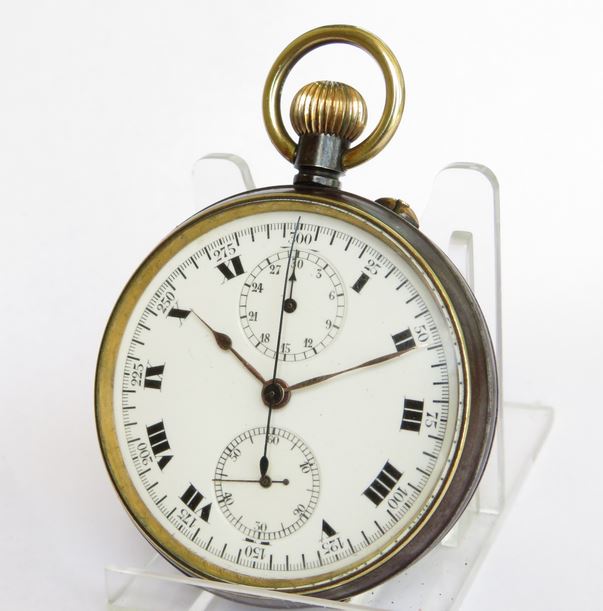The Heuer Watch Company was founded by Edouard Heuer (1840-1892). Heuer was born the son of a shoemaker in Brügg, in the canton of Bern, Switzerland. At the age of 14, he started an apprenticeship as a watchmaker. In 1860, Heuer opened a watchmaking workshop in St-Imier, a small village in the Swiss Jura region about 20km from his home town. The company was known as Uhrenmanufaktur Heuer AG (English translation: Heuer Watchmaking Inc.).
In 1864, Heuer moved the company to his home town, Brugg, where it operated as Edouard Heuer & Compagnie. In 1867, Heuer moved the company again to the town of Bienne, in the canton of Bern. The company would remain in Bienne for well over 100 years.
Patents
In 1869 Heuer registered his first patent for a keyless, crown-operated winding system for pocket watches. This new winding crown replaced the separate key that had been required to wind a watch. In the 1880s, sporting competitions were becoming more popular and organised. Heuer realised that accurate pocket chronographs were important to these events. In 1882, Heuer patented the company’s first chronograph. In 1887, Heuer patented the “oscillating pinion” for chronographs. It consisted of a movable shaft with two differently-toothed gears. The mechanism could be used to make the chronograph function start or stop by simply operating on the respective push buttons. The oscillating pinion is still being used by modern watchmakers of mechanical chronographs.
Edouard’s sons, Jules-Edouard and Charles-Auguste took over the company when their father died in 1892. At the start of the 20th century, technological innovations in industry, transportation, science and medicine increased demands for more precise timing. In 1908, Charles-Auguste Heuer patented the Sphygmometer pocket chronograph. It allowed a doctor to determine the patient’s pulse rate, after counting heartbeats for only 20 seconds.
Chronographs
In the world of sports, demands for accurate timing became more critical, as competitors might be separated by mere hundredths of a second. In 1916, as a result of these demands, Charles-Auguste Heuer invented the Mikrograph and Microsplit (with split-seconds), the first chronographs capable of timing to 1/100th of a second. These were followed by the Semikrograph and Semicrosplit, capable of timing to 1/50th of a second.
In the early 20th century, travel by automobile and air became more common. In 1911, this inspired Heuer to design an instrument that could be mounted on the dashboard of these vehicles. It was called the “Time of Trip” clock. It was a precision chronograph, indicating the time of day on the main dial, while two hands on a smaller dial recorded the duration of a journey. The driver or pilot used a pusher to start and stop this “Time of Trip” recorder.
In 1914, Heuer created the first wrist chronograph, just as wristwatches were about to become more practical. Heuer’s split-second pocket chronographs were chosen as official timekeeping instruments for the Olympic Games in Antwerp in 1920, Paris in 1924 and Amsterdam in 1928.
Later years
In the decades that followed, Heuer focussed on the relationship that had been established with the automobile and airline industries. During the 1930’s they began producing chronographs that were specifically made for pilots. In 1933 Heuer introduced another dashboard instrument called the “Autavia”. Its name was a contraction of AUTomobile and AVIAtion. This instrument featured a timer function and could run for 8 days without rewinding. Between 1935 and the early 1940s, Heuer manufactured chronographs for pilots in the Luftwaffe, the aerial warfare branch of the German armed forces during World War II. In 1958, Jack W. Heuer, the great-grandson of the company founder, began his involvement in the company. He would become the managing director and was closely associated with the brand for decades.
Classic designs
In 1962, Heuer became the first Swiss watchmaker in space when John Glenn used a Heuer stopwatch when he piloted the Mercury spacecraft on the first US crewed space flight to orbit the Earth. In 1963, Heuer introduced the classic Carrera chronograph, designed by Jack Heuer. The revolutionary, Heuer Monaco was introduced in 1969 in honour of the Monaco Grand Prix. It was the first automatic square-cased chronograph and was made famous by star Steve McQueen in the 1971 film Le Mans.
In 1985, Heuer was acquired by the TAG Group, forming TAG Heuer. The name TAG Heuer combines the initials of “Techniques d’Avant Garde” and the founder’s surname. As we have ventured far away from the world of antique watches, I’ll stop the Heuer history lesson here.
Related content
TAG Heuer at Wikipedia.
TAG Heuer website.
